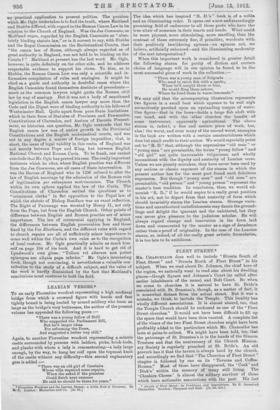FLEET STREET.*
MR. CHANCELLOR does well to include "Streets South of Fleet Street" and " Streets North of Fleet Street" in his subject. When we read about Dr. Johnson, the chief hero of the region, we naturally want to read also about his dwelling places—Gough Square and Johnson's Court (so called after earlier inhabitants of the name) and Bolt Court. So when we come to churches it is natural to have St. Bride's associated with St. Dunstan's, though, as a matter of fact, it is somewhat distant from the actual street. But it was a mistake, we think, to include the Temple. This locality has wholly different associations. It is almost absurd, too, that the Temple Church should be reckoned as one of the "Fleet Street churches." It would not have been difficult to fill up the space that would have been thus vacated. A complete list of the vicars of the two Fleet Street churches might have been profitably added to the particulars which Mr. Chancellor has been at pains to collect. We might have been told, too, that the patronage of St. Dunstan's is in the hands of the Simeon Trustees and that the anniversary of the Church Mission- ary Society is regularly preached at St. Bride's. An old proverb has it that the tavern is always hard by the church, and accordingly we find that " The Churches of Fleet Street " chapter is followed by one on its " Taverns and Coffee- Houses." Most of these have disappeared, the Cock' and `Dick's' within the memory of many still living. The Cheshire Cheese' is almost the solitary survivor of those which have noticeable associations with the past. His last Annals of Fleet Street: its Traditions and Associations. By E. Berestord Chancellor. London: Chapman and Hall. [Th. ed. net.]
chapter Mr. Chancellor gives to "Fleet Street and the Press." The "Press" is now represented by newspapers as it once was by books. At one time it was almost as much occupied by publishers as Paternoster Row is now. The last of the craft to leave it were Seeleys, who had their warehouse at 54, on the south side, and Bell, whose habitat was close to SL Dunstan's Church. A very large proportion of the thoroughfare and its approaches is now occupied by London and provincial journals. Mr. Chancellor names " Racquet Court" as one of the streets on the north side. Could he not have told us how it got its name ? We notice a mis- print on page 69, where Robert Lovett, Johnson's servant, is said to have been buried in 1732. The date should have been 1782.











































 Previous page
Previous page